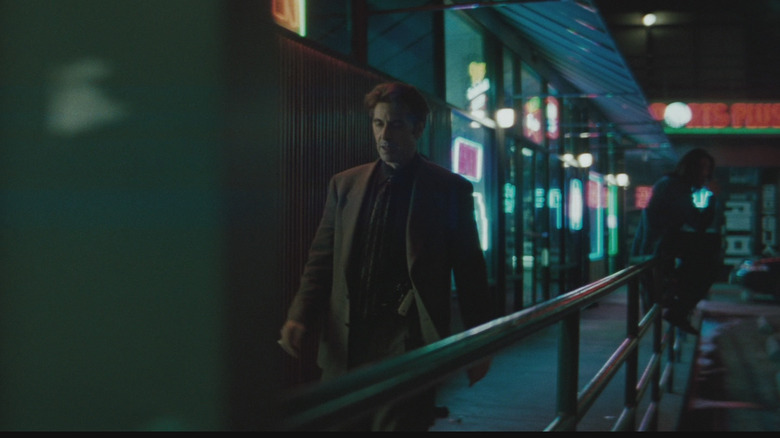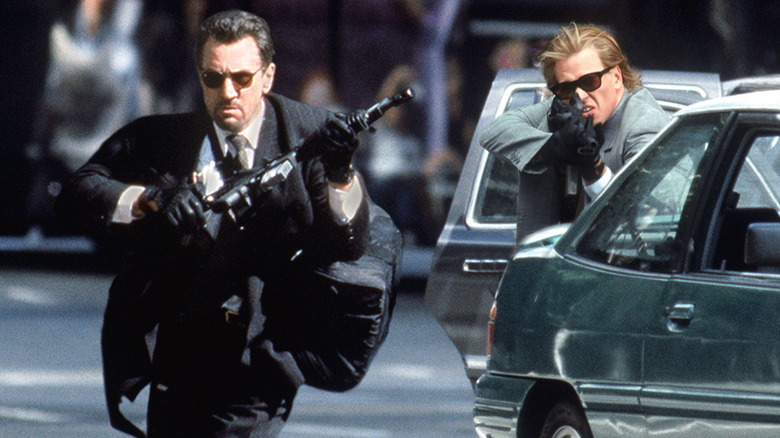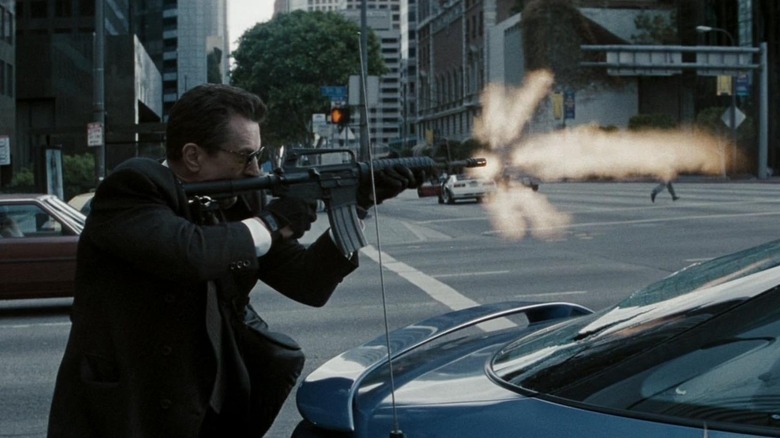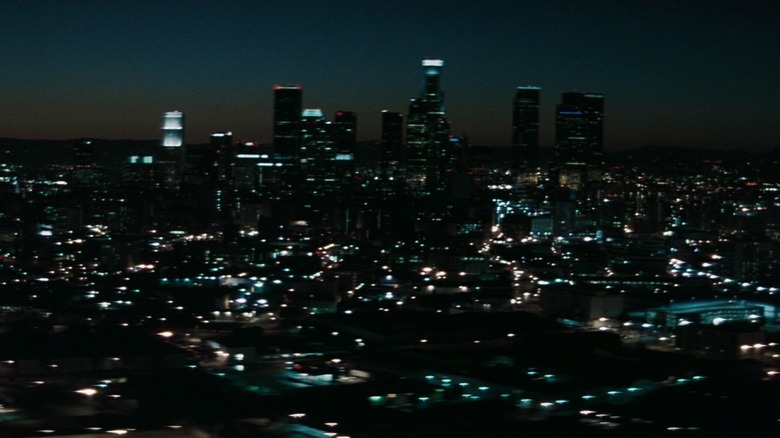The Scouting Process For Heat Was About A Lot More Than Location
To paraphrase Michael Cheritto (Tom Sizemore) in 1995's "Heat": For filmmaker Michael Mann, the research is the juice. Mann's fifth theatrical feature may sound hopelessly basic and standard if reduced to a mere logline, with "Heat" being about a burnt-out cop caught in a game of cat and-mouse with a world-weary criminal mastermind. Yet when one starts examining beneath the surface — the cop, Vincent Hanna, would be played by Al Pacino, and the criminal, Neil McCauley, would be played by Robert De Niro, and the film would feature their first-ever scene together — "Heat" becomes infinitely deeper and more intriguing, and that's before considering the massive number of supporting characters and plot lines surrounding the central conflict.
The depth is thanks in large part to Mann's copious methods of research that enrich all his projects. In addition to chronicling the lives of numerous people, "Heat" is very much a story set in and about Los Angeles. The city is depicted in the film in a way that's completely unique to Mann and his vision, with the director helping research and compile detail after detail that supports and contextualizes the characters and their story. The task began immediately with the start of preproduction, as Mann and his crew began looking for the locations where they were to make the film, and the crew quickly discovered that the process was just as important as its end result.
Mann makes Heat a tale of two cities
"Heat" is based on the real-life exploits of Detective Chuck Adamson, who had his own arch villain in the form of heist master Neil McCauley, with their showdown occurring during the early 1960s in Michael Mann's home city of Chicago.
It's not entirely clear why Mann didn't want "Heat" to take place in Chicago. He'd made his debut feature, "Thief," there, and Mann has always had a strict attitude of fidelity toward adapting material. Perhaps the L.A. setting was a way of redeeming the material, since "Heat" initially existed in the form of a failed 1989 TV pilot Mann made titled "L.A. Takedown," set in the city likely for budgetary and potential future series production reasons. (Other material from Adamson's life also found its way into Mann's "Crime Story" series, which was set in Chicago.)
In any case, Mann wished to embrace the L.A. setting fully, making it part of the movie's tapestry. According to production designer Neil Spisak in "The Making of Heat" documentary:
"[Mann] was interested in portraying Los Angeles in a completely different way than we had ever seen it before, and that it was to be an intricate part of the story in terms of all of the bits and pieces of places and spaces that the different characters of this movie occupied, and how they all fit together to be a portrait of Los Angeles that is one that we were not familiar with."
Cinematographer Dante Spinotti observed how the setting became entwined with its characters, stating: "One side of the story is the city, Los Angeles, and the other side is the conflict ... the relationship between McCauley and Hanna ... Maybe Michael Mann's idea to choose these two characters to explain Los Angeles, and vice-versa."
Mann introduces the cast and crew to Heat's Los Angeles
With the intention to make Los Angeles more than just a mere setting in "Heat," Michael Mann embarked on a location scout that would best explain to his crew what his ambitions were for the movie. As Dante Spinotti explained:
"Michael took a group of us on a never-ending helicopter flight over the city. It's also a way that Michael Mann has to explain a movie to his collaborators, which is not about details. He starts with the broad concept. So the fact that we flew over the city for three endless hours, just looking for a possible location for the movie, gave me a vision of where we were going to set our story."
Spinotti, now on board with Mann's vision, worked in conjunction with the director to create a visual collage that would function as a proof-of-concept for both cast and crew. He explained how he and Mann "would go around the city and shoot photographs of things. Not necessarily a location, but it could be a crucifix, it could be a weird restaurant, it could be ... something that had a piece, or an idea, that might contribute to the scenes."
Mann and Spinotti then constructed "a huge room with a number of photographs," as the cinematographer described it, with pictures pertaining to both location possibilities as well as images meant to evoke the film's mood. Actress Ashley Judd (who plays Charlene Shiherlis, long-suffering wife of McCauley's crew member Chris) recalled seeing a room that had "incredible pieces of still photography that [Mann and Spinotti] were using both for composition and color, and I could see already that the palette was cool, it was very blue and very gray."
Heat is inextricable from its locations
Some stories are timeless and relatable enough that they can be set just about anywhere, while others become so tied to their setting that it's nearly impossible to imagine them taking place anywhere else. The latter was Michael Mann's goal on "Heat," and it's clear from the reaction to the film that he achieved it. The film's centerpiece action sequence is referred to as "the downtown shootout," and the infamous scene where Hanna and McCauley meet is referred to as "the diner scene," the locations being strongly linked to these moments.
Looking at Mann's filmography in a broad overview, so many of his films are informed by the concept of incarceration, and L.A. is treated in "Heat" like it's some kind of prison. Not just for the characters, but for the viewer — the only way "in" and "out" of the movie is at a site for transportation, a train station and airport, respectively. The film's locations are as famous for fans of the movie as its actors are, and as location scout Lori Balton (location manager Janice Polley's colleague) recalled in 2019, "I get emails every couple of months from people asking me where this was in 'Heat,' where was that in 'Heat.'" Clearly, Mann's methodology for location scouting and beyond is much ado about something.



